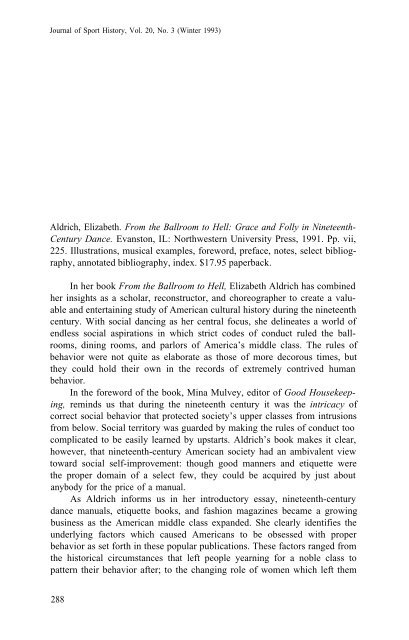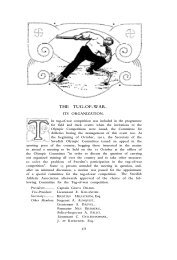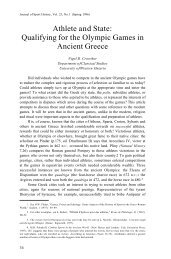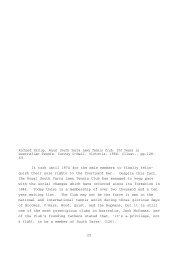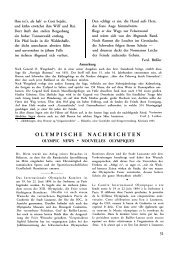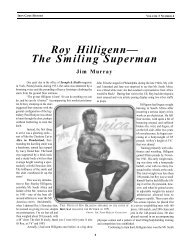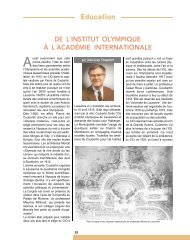Aldrich, Elizabeth. From the Ballroom to Hell
Aldrich, Elizabeth. From the Ballroom to Hell
Aldrich, Elizabeth. From the Ballroom to Hell
You also want an ePaper? Increase the reach of your titles
YUMPU automatically turns print PDFs into web optimized ePapers that Google loves.
Journal of Sport His<strong>to</strong>ry, Vol. 20, No. 3 (Winter 1993)<br />
<strong>Aldrich</strong>, <strong>Elizabeth</strong>. <strong>From</strong> <strong>the</strong> <strong>Ballroom</strong> <strong>to</strong> <strong>Hell</strong>: Grace and Folly in Nineteenth-<br />
Century Dance. Evans<strong>to</strong>n, IL: Northwestern University Press, 1991. Pp. vii,<br />
225. Illustrations, musical examples, foreword, preface, notes, select bibliography,<br />
annotated bibliography, index. $17.95 paperback.<br />
In her book <strong>From</strong> <strong>the</strong> <strong>Ballroom</strong> <strong>to</strong> <strong>Hell</strong>, <strong>Elizabeth</strong> <strong>Aldrich</strong> has combined<br />
her insights as a scholar, reconstruc<strong>to</strong>r, and choreographer <strong>to</strong> create a valuable<br />
and entertaining study of American cultural his<strong>to</strong>ry during <strong>the</strong> nineteenth<br />
century. With social dancing as her central focus, she delineates a world of<br />
endless social aspirations in which strict codes of conduct ruled <strong>the</strong> ballrooms,<br />
dining rooms, and parlors of America’s middle class. The rules of<br />
behavior were not quite as elaborate as those of more decorous times, but<br />
<strong>the</strong>y could hold <strong>the</strong>ir own in <strong>the</strong> records of extremely contrived human<br />
behavior.<br />
In <strong>the</strong> foreword of <strong>the</strong> book, Mina Mulvey, edi<strong>to</strong>r of Good Housekeeping,<br />
reminds us that during <strong>the</strong> nineteenth century it was <strong>the</strong> intricacy of<br />
correct social behavior that protected society’s upper classes from intrusions<br />
from below. Social terri<strong>to</strong>ry was guarded by making <strong>the</strong> rules of conduct <strong>to</strong>o<br />
complicated <strong>to</strong> be easily learned by upstarts. <strong>Aldrich</strong>’s book makes it clear,<br />
however, that nineteenth-century American society had an ambivalent view<br />
<strong>to</strong>ward social self-improvement: though good manners and etiquette were<br />
<strong>the</strong> proper domain of a select few, <strong>the</strong>y could be acquired by just about<br />
anybody for <strong>the</strong> price of a manual.<br />
As <strong>Aldrich</strong> informs us in her introduc<strong>to</strong>ry essay, nineteenth-century<br />
dance manuals, etiquette books, and fashion magazines became a growing<br />
business as <strong>the</strong> American middle class expanded. She clearly identifies <strong>the</strong><br />
underlying fac<strong>to</strong>rs which caused Americans <strong>to</strong> be obsessed with proper<br />
behavior as set forth in <strong>the</strong>se popular publications. These fac<strong>to</strong>rs ranged from<br />
<strong>the</strong> his<strong>to</strong>rical circumstances that left people yearning for a noble class <strong>to</strong><br />
pattern <strong>the</strong>ir behavior after; <strong>to</strong> <strong>the</strong> changing role of women which left <strong>the</strong>m<br />
288
Book Reviews<br />
confined—more or less-<strong>to</strong> <strong>the</strong>ir homes with little else <strong>to</strong> do but oversee <strong>the</strong><br />
details of <strong>the</strong>ir social microcosms.<br />
As mentioned earlier, <strong>Aldrich</strong>’s central point of reference is <strong>the</strong> social<br />
dance arena; but, she also underscores <strong>the</strong> fact that <strong>the</strong> daily social interactions<br />
of upwardly mobile Americans was just as meticulously patterned as <strong>the</strong><br />
steps and figures of <strong>the</strong>ir dances. Through <strong>the</strong> delightful collection of short<br />
excerpts from dance manuals and o<strong>the</strong>r publications, she provides us with<br />
glimpses of <strong>the</strong> cotillions, quadrilles, and waltzes which reflected changing<br />
tastes in dance from decade <strong>to</strong> decade, and she reminds us how often dance<br />
becomes <strong>the</strong> quintessential marker of a people’s ideals and aspirations. By<br />
showing us how fashion, etiquette, and dance were seamlessly woven <strong>to</strong>ge<strong>the</strong>r<br />
in <strong>the</strong> nineteenth-century mind, she also reminds us of our own misleading<br />
tendency <strong>to</strong> try <strong>to</strong> divide elements of culture in<strong>to</strong> distinct categories<br />
which can be examined independently of each o<strong>the</strong>r.<br />
For those who wish <strong>to</strong> fur<strong>the</strong>r explore <strong>the</strong> primary resources drawn upon<br />
by <strong>the</strong> author, a detailed and lengthy Annotated Bibliography makes for<br />
interesting reading in itself.<br />
University of Illinois John O. Perpener III<br />
289


